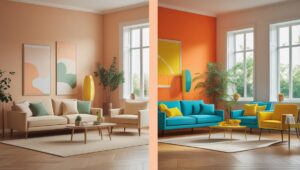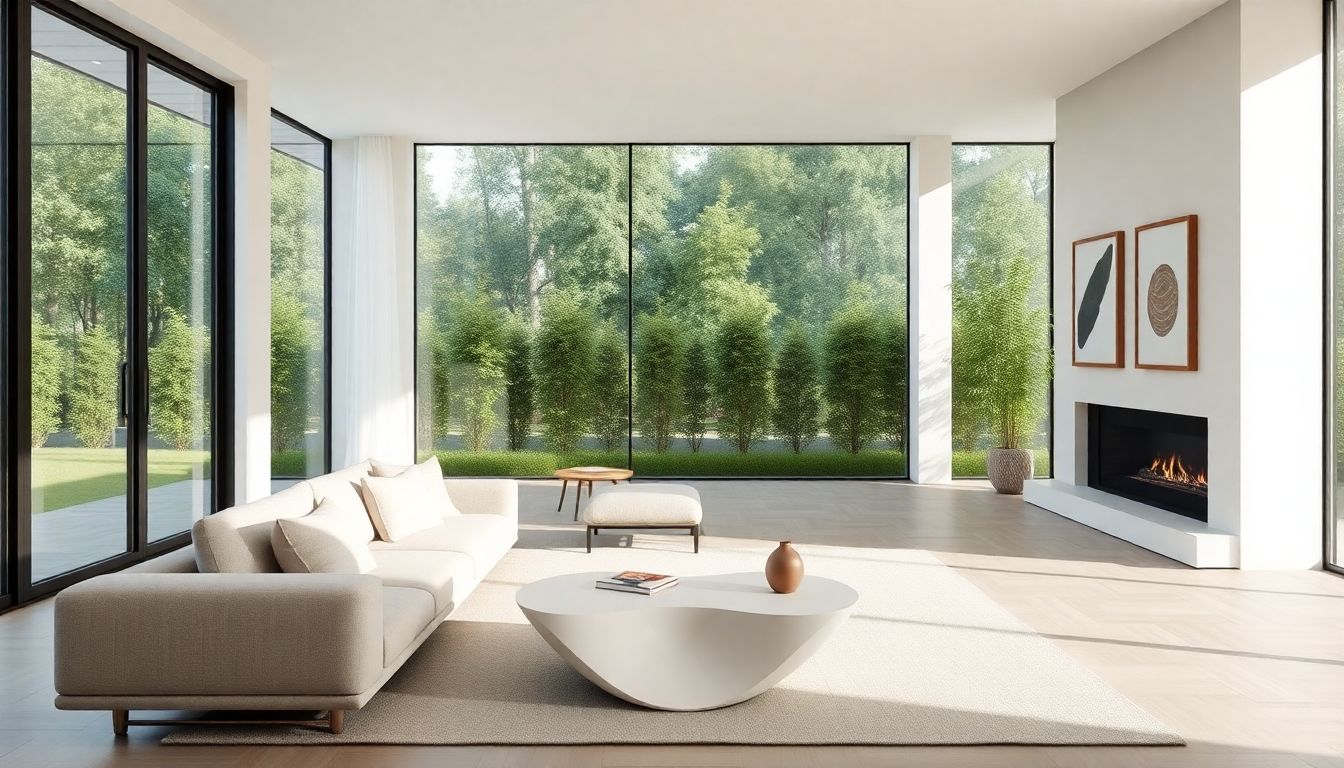
Interior design has the transformative power to turn ordinary spaces into extraordinary ones. Ever felt instant peace stepping into a harmonious room? Or unease in a poorly planned one? That’s the magic of interior design—it directly shapes our well-being and quality of life.
Tired of bland spaces, bad lighting, or wasted square footage? You’re not alone. Interior design goes beyond mere decoration—it’s the art and science of crafting functional, beautiful spaces tailored to their users. In this complete guide, we’ll cover everything from core principles to practical tips for revamping any room.
1. Interior Design Fundamentals
Effective interior design rests on principles and elements that, when applied well, create balanced, functional spaces. Mastering these basics is key for any project, whether led by a pro or a DIY enthusiast.
Essential Interior Design Principles
Interior design principles are guidelines ensuring balance and visual unity. They’re the backbone of every successful project:
- Balance: The visual distribution of elements. It can be symmetrical (mirrored items), asymmetrical (varied items with equal visual weight), or radial (elements radiating from a center). Think matching nightstands for symmetrical balance.
- Emphasis: A focal point that draws the eye and anchors the space—like a bold artwork, fireplace, or accent wall. A vibrant chair in a neutral room nails this principle.
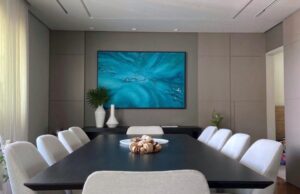
- Harmony: Blending unity (cohesion) with variety (visual interest). A harmonious space pairs complementary elements without feeling dull—like similar tones with varied textures.
- Proportion and Scale: The size relationship between objects and the room. Proportional furniture ensures comfort and flow. A massive sofa in a tiny room or a puny rug under a dining table throws this off.
- Rhythm: Visual movement via repetition, progression, or transitions. It guides the eye smoothly—like a row of frames or evenly spaced lights.
Pro Tip: Start your interior design by spotting the room’s natural focal point. Build around it, respecting balance and proportion—it simplifies planning.
Core Interior Design Elements
Elements are the building blocks of interior design—tools to bring principles to life:
- Space: The designer’s canvas. It’s positive (filled) and negative (empty). Balancing both prevents cramped or barren rooms.
- Line: Shapes forms and directs the eye. Horizontal lines calm, verticals lift, diagonals energize.
- Form: The shape of objects and spaces. Geometric forms (squares, circles) bring order; organic curves add softness.
- Light: A game-changer that reveals textures, sets mood, and boosts function.
- Color: An emotional powerhouse in interior design. Warm tones (red, orange) energize; cool ones (blue, green) soothe. Color theory ensures harmony.
- Texture: The feel or look of surfaces. Mixing smooth and rough adds depth and richness.
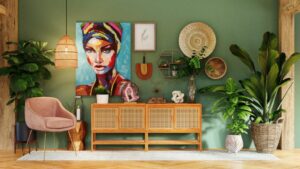
2. Popular Interior Design Styles
Interior design spans a vast array of styles, each reflecting unique eras, cultures, and philosophies. Knowing them helps you pinpoint your vibe and craft spaces that scream “you.”
Modern Interior Design
Modern interior design emerged as a rebellion against over-the-top ornamentation, favoring function and simplicity. Key traits:
- Clean lines and geometric shapes.
- No frills or excess decor.
- Function-first approach.
- Materials like metal, glass, and light wood.
- Neutral palette with pops of color.
Perfect for practicality lovers, it delivers calm, clutter-free spaces—like a living room with a sleek sofa, glass-metal coffee table, and white walls with geometric art.
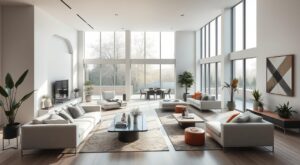
Contemporary Interior Design
Often mixed up with modern, contemporary interior design mirrors current trends and evolves constantly. Features:
- Trend-driven flexibility.
- Innovative, eco-friendly materials.
- Open, flowing spaces.
- Tons of natural light.
- Contrasting textures.
- Integrated tech.
Ideal for trendsetters who love dynamic spaces—like exposed concrete, reclaimed wood, and designer pieces.
Key Difference: Modern interior design is a fixed 20th-century style; contemporary reflects the “now.” Modern is timeless; contemporary is today.
Scandinavian Interior Design
Born in Nordic countries, Scandinavian interior design blends simplicity, function, and coziness. Hallmarks:
- Functional minimalism with warm touches.
- Light palette, heavy on white.
- Light woods like pine or oak.
- Max natural light.
- Natural textures in rugs, throws, and pillows.
- Plants as must-have decor.
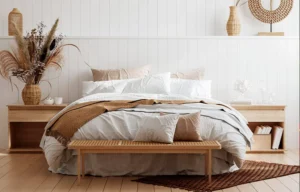
Bohemian Interior Design
Bohemian (boho) interior design celebrates creative freedom and eclectic vibes. Traits:
- Wild mix of patterns, textures, and bold colors.
- Global cultural influences and handmade touches.
- Tons of plants and natural elements.
- Vintage or weathered furniture.
- Handcrafted textiles like macramé and tapestries.
- Laid-back, unconventional layouts.
Great for free spirits who love originality—like layered rugs, floor pillows, hanging plants, and travel finds.
Traditional Interior Design
Traditional interior design draws from history for timeless elegance. Features:
- Classic furniture with ornate finishes.
- Symmetry and order.
- Luxe fabrics like silk, damask, and velvet.
- Rich, warm colors—reds, blues, greens.
- Decorative details in frames, chandeliers, and accessories.
- Dark, carved woods.
Suits those craving classic sophistication—like plush sofas with pillows, dark wood side tables, and formal drapes.
3. Planning Your Interior Design Project
Solid planning is the bedrock of a winning interior design project. It saves time, money, and headaches, ensuring the outcome matches your vision.
Defining Needs and Style in Interior Design
Before picking colors or furniture, nail down the space’s purpose and your aesthetic. Steps to kick off your interior design project:
- Pinpoint priorities: What’s the room for? More storage? Better task lighting? A cozy retreat?
- Assess your lifestyle: Kids or pets? Frequent guests? Work-from-home setup? This shapes material and layout choices.
- Get inspired: Browse magazines, websites, and platforms like Pinterest or Instagram for interior design ideas.

A mood board—digital or physical with images, swatches, and materials—visualizes how elements gel and guides your interior design journey.
Practical Tip: Build a digital mood board on Canva or Pinterest, or a physical one with magazine clippings and fabric samples. It keeps your interior design vision cohesive.
Measuring and Space Planning
Precise measurements prevent costly mistakes in interior design:
- Measure accurately: Use a tape measure for room dimensions (length, width, height), including doors, windows, and outlets.
- Draw a floor plan: Sketch to scale or use interior design tools like SketchUp, Planner 5D, or RoomSketcher.
- Plan traffic flow: Ensure 28-35 inches (70-90 cm) for walkways.
- Test layouts: Try multiple furniture setups—3D previews in apps help.

Budgeting and Sourcing in Interior Design
Managing costs is critical in interior design:
- Set a realistic budget: Cap your spending, factoring in furniture, materials, and labor.
- Prioritize spending: Focus on key items—like a sofa or lighting in a living room.
- Shop smart: Compare prices online and in-store; explore second-hand or vintage finds.
- Buffer for surprises: Add 10-15% for unexpected costs, common in interior design.
Smart Move: Break your interior design project into phases if funds are tight. Start with essentials and build over time—spreading costs and refining choices.
4. Practical Tips to Elevate Your Space
Even without a full interior design overhaul, small tweaks can work wonders. These tips boost function and flair in any room.
Maximizing Small Spaces with Interior Design
Tiny apartments and rooms are a fun interior design challenge. Smart strategies make them functional and spacious:
- Use mirrors wisely: Place them to reflect light or windows for a bigger, brighter feel.
- Go light: White, beige, and soft gray walls and ceilings open up space. Add color via small, swap-friendly items.
- Pick multi-use furniture: Think sofa beds, extendable tables, storage ottomans, or beds with drawers.
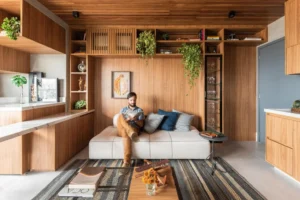
- Use vertical space: Tall shelves, niches, and floor-to-ceiling cabinets free up floor area.
- Declutter: Minimalism is your friend in interior design for small spaces—keep only what you need.
- Scale furniture right: Proportional pieces with visible legs feel lighter and less cramped.
Visual Trick: In small-space interior design, hang curtains near the ceiling and let them reach the floor for a taller, airier look.
Lighting Strategies in Interior Design
Lighting transforms interior design, impacting function and mood. A solid plan layers:
- Layer light: Mix general (whole-room), task (activity-specific), and accent (highlighting decor) lighting.
- Choose fixtures wisely: Pendants for dining, lamps for reading, spots for art—match to purpose.
- Mind color temperature: Warm (2700K-3000K) for cozy vibes; cool (4000K-5000K) for work zones.
- Add dimmers: Adjust brightness for different moods or times.

Adding Personality and Character to Interior Design
The best interior design reflects its inhabitants. Personal touches turn generic into unique:
- Show off art and photos: Paintings, sculptures, or personal pics add meaning. Wall galleries with mixed frames are hot in interior design.
- Highlight collections: Books, records, or travel souvenirs shine on shelves or niches.
- Bring in nature: Plants, wood, and stone add life and texture—key in modern interior design.
- Mix old and new: Vintage heirlooms with sleek pieces create depth.
Personal Touch: In interior design, there’s no “must-have.” Make it yours—choose what brings joy and comfort.
5. Common Interior Design Mistakes to Avoid
Even with great intentions, interior design slip-ups happen. Spotting common pitfalls keeps your project on track.
Scale and Proportion Issues
Scale and proportion blunders are top interior design mistakes:
- Oversized furniture: Too-big pieces crowd and clog flow—measure first.
- Tiny rugs: Rugs should fit under front furniture legs; small ones chop up the space.
- Wrong curtains: Short or narrow drapes shrink windows. Pros hang them high and wide.
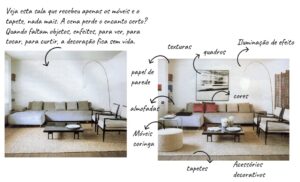
Overstuffing with furniture or decor is another miss. Modern interior design loves negative space—room to breathe and move.
Overlooking Functionality in Interior Design
Favoring looks over use is a classic interior design error:
- Uncomfy furniture: Pretty but stiff chairs or sofas flop fast—ergonomics matter.
- No storage: Clutter creeps in without enough spots for stuff—add shelves or cabinets.
- Poor lighting: Dim or wrong lights hinder tasks—plan for each activity.
- Bad layout: Furniture blocking paths cramps flow—keep 28-35 inches (70-90 cm) clear.
Quick Test: Before locking in your interior design, test daily tasks—sitting, standing, opening doors, using surfaces.
Off-Base Color Choices in Interior Design
Colors shape mood and space perception—mistakes here hit hard:
- Too much bold: Vibrant hues energize but overdone tire the eyes—use sparingly.
- Ignoring natural light: Colors shift with light—test swatches all day.
- Clashing combos: Unmatched tones jar—lean on color theory.
- Missing psychology: Red’s too loud for bedrooms; icy blue chills dining vibes.

Frequently Asked Questions About Interior Design
What’s the difference between interior design and decoration?
Interior design is broader, tackling full spatial planning—structure, function, and aesthetics. Decoration is a subset, focusing on visual flair. Designers might tweak layouts or lighting; decorators polish with finishes.
How much does an interior design project cost?
Costs for interior design vary by scope and customization. Pros charge hourly ($75-$250), per square foot ($5-$15/ft²), or flat rates per room. Add furniture, materials, and labor costs. Save with targeted consults or partial plans.
How do I pick the right interior design style for my home?
Find your interior design style by noting spaces you love, reflecting on your fashion taste, and collecting inspo pics. Match it to your life—families need durability; entertainers prioritize social zones. Mix styles for a custom fit.
Can I do interior design on a budget?
Yes! Budget-friendly interior design thrives on planning and creativity. Focus on key pieces (sofa, bed), refresh old furniture, hit thrift stores, phase the project, and use high-impact, low-cost moves like paint and plants.
How do I blend tech into interior design?
In contemporary interior design, tech should enhance without clashing. Plan wiring early, use furniture with built-in chargers, add smart lighting or curtains, integrate audio-visual seamlessly, and hide cords smartly.
Transform Your Space with Interior Design
Interior design isn’t just about looks—it’s a game-changer for life quality. Well-planned spaces lift mood, productivity, and comfort, welcoming and inspiring us.
This guide unpacked interior design basics—principles, styles, and actionable tips. Great design marries beauty and function, balancing rules with personal flair.
Start Your Makeover Today!
Don’t wait to craft your dream space! Pick one interior design tip that clicks and try it this week. Start small—shift furniture, add pillows or plants—and feel the shift.
Interior design evolves with you—keep tweaking as needs and tastes shift. Build spaces that support and reflect your journey.
